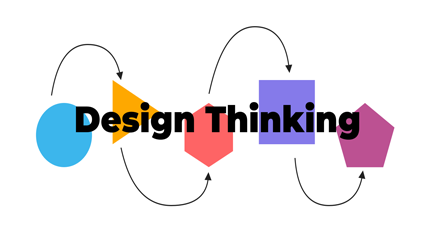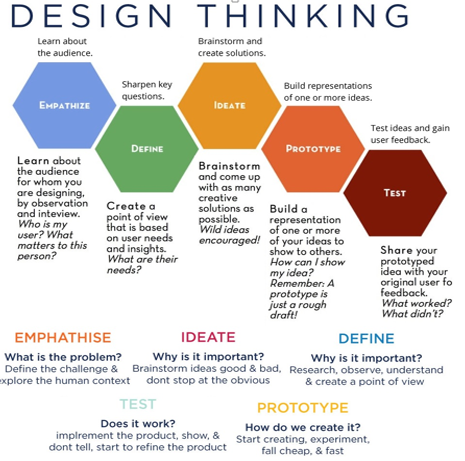Design Thinking

Design Thinking is a design methodology that offers a solution-based approach to solving problems. It’s exceptionally helpful and constructive in tackling intricate problems that are indefinable or unknown, by understanding the human needs involved, by re-framing the problem in human-centric ways, by creating many ideas in brainstorming sessions, and by adopting a hands-on approach in prototyping and testing.
Understanding the Design Thinking will empower anyone to apply the Design Thinking methods to solve complex problems that occur around us
WICKED PROBLEMS Design Thinking is a methodology that aims to tackle highly complex problems. Complex problems—otherwise known as “wicked” problems— are those that are difficult to define and cannot be solved using standard methods and approaches. They are the opposite of “tame” problems, which can be solved by applying a tried-and-tested algorithm or logic
Wicked problems don’t have a final solution. Things like climate change, poverty, and world hunger are often-cited examples of wicked problems; they need to be tackled from multiple angles, and rather than looking for a single answer, they require a response that anticipates how the problem might evolve and mutate.
OUTISDE-THE-BOX APPROCH- Design Thinking fosters an outside-the-box approach, with huge emphasis on creativity, innovation, and the needs of the user. The Design Thinking process is used to apply the Design Thinking ideology to real-world, wicked problems. It offers a solution-based approach to problem-solving.
FIVE PHASES Design thinking is a non-linear, iterative process that teams use to understand users, challenge assumptions, redefine problems and create innovative solutions to prototype and test. Involving five phases—Empathize, Define, Ideate, Prototype and Testit is most useful to tackle problems that are ill-defined or unknown.

Stage 1: Empathize—Research Your Users' Needs
 The Design Thinking process starts with empathy. In order to create desirable products and services, you need to understand who your users are and what they need. What are their expectations in relation to the product you’re designing? What challenges and pain-points do they face within this context?
The Design Thinking process starts with empathy. In order to create desirable products and services, you need to understand who your users are and what they need. What are their expectations in relation to the product you’re designing? What challenges and pain-points do they face within this context?
During the empathize phase, you’ll spend time observing and engaging with real users (or people who represent your target group)—conducting interviews, seeing how they interact with an existing product, and generally paying attention to facial expressions and body language.
As the first step in the Design Thinking process, the empathize phase encourages you to set your assumptions aside. Armed with first-hand insights, you’ll be able to design with real users in mind. That’s what Design Thinking is all about!
Here, you should gain an empathetic understanding of the problem you’re trying to solve, typically through user research. Empathy is crucial to a human-centered design process
What? During the empathize phase, you’ll engage with and observe your target audience.
Why? The aim of this step is to paint a clear picture of who your end users are, what challenges they face, and what needs and expectations must be met.
How? In order to build user empathy, you’ll conduct surveys, interviews, and observation sessions.
Stage 2: Define—State Your Users' Needs and Problems
 In the second stage of the Design Thinking process, you’ll define the user problem that you want to solve. First, you’ll gather all of your findings from the empathize phase and start piecing them together. What common themes and patterns did you observe? What user needs and challenges consistently came up?
In the second stage of the Design Thinking process, you’ll define the user problem that you want to solve. First, you’ll gather all of your findings from the empathize phase and start piecing them together. What common themes and patterns did you observe? What user needs and challenges consistently came up?Once you’ve synthesized your findings, you’ll formulate what’s known as a problem statement. A problem statement—sometimes called a point of view (POV) statement—outlines the issue or challenge that you will seek to address.
By the end of the define phase, you will have a clear problem statement which will guide you throughout the design process. This will form the basis of your ideas and potential solutions.
What? Based on what you’ve learned in the empathize phase, the next step is to define a clear problem statement.
Why? Your problem statement sets out the specific challenge you will address. It will guide the entire design process from here on out, giving you a fixed goal to focus on and helping to keep the user in mind at all times.
How? When framing your problem statement, you’ll focus on the user’s needs rather than those of the business. A good problem statement is human-centered, broad enough for creativity, yet specific enough to provide guidance and direction.
Stage 3: Ideate—Challenge Assumptions and Create Ideas
 The third stage in the Design Thinking process consists of ideation—or generating ideas. By this point, you know who your target users are and what they want from your product. You also have a clear problem statement that you’re hoping to solve. Now it’s time to come up with possible solutions.
The third stage in the Design Thinking process consists of ideation—or generating ideas. By this point, you know who your target users are and what they want from your product. You also have a clear problem statement that you’re hoping to solve. Now it’s time to come up with possible solutions.The ideation phase is encouraged to venture away from the norm, to explore new angles, and to think outside the box, to generate as many ideas as possible—regardless of whether or not they’re feasible!
Now, you’re ready to generate ideas, look for alternative ways to view the problem and identify innovative solutions to the problem statement you’ve created, narrow it down to a few ideas which you’ll later turn into prototypes to be tested on real users. Brainstorming is particularly useful here.
What? With a clear problem statement in mind, you’ll now aim to come up with as many ideas and potential solutions as possible.
Why? The ideation phase gets you thinking outside the box and exploring new angles. By focusing on quantity of ideas rather than quality, you’re more likely to free your mind and stumble upon innovation!
How? During dedicated ideation sessions, you’ll use a range of different ideation techniques such as brain storming, reverse thinking, and worst possible idea.
Stage 4: Prototype—Start to Create Solutions
 In the fourth stage of the Design Thinking process, you’ll turn your ideas from stage three into prototypes. A prototype is essentially a scaled-down version of a product or feature—be it a simple paper model or a more interactive digital representation.
In the fourth stage of the Design Thinking process, you’ll turn your ideas from stage three into prototypes. A prototype is essentially a scaled-down version of a product or feature—be it a simple paper model or a more interactive digital representation.The aim of the prototyping stage is to turn your ideas into something tangible which can be tested on real users. This is crucial in maintaining a user-centric approach, allowing you to gather feedback before you go ahead and develop the whole product. This ensures that the final design actually solves the user’s problem and is a delight to use!
This is an experimental phase. The aim is to identify the best possible solution for each problem found, produce some inexpensive, scaled-down versions of the product (or specific features found within the product) to investigate the ideas you’ve generated. This could involve simply paper prototyping.
What? Having narrowed your ideas down to a select few, you’ll now turn them into prototypes—or “scaled-down” versions of the product or concept you want to test.
Why? The prototyping stage gives you something tangible that can be tested on real users. This is crucial in maintaining a user-centric approach.
How? Depending on what you’re testing, prototypes can take various forms—from basic paper models to interactive, digital prototypes. When creating your prototypes, have a clear goal in mind; know exactly what you want your prototype to represent and therefore test.
Stage 5: Test—Try Your Solutions Out
 The fifth step in the Design Thinking process is dedicated to testing: putting your prototypes in front of real users and seeing how they get on. During the testing phase, you’ll observe your target users—or representative users—as they interact with your prototype. You’ll also gather feedback on how your users felt throughout the process.
The fifth step in the Design Thinking process is dedicated to testing: putting your prototypes in front of real users and seeing how they get on. During the testing phase, you’ll observe your target users—or representative users—as they interact with your prototype. You’ll also gather feedback on how your users felt throughout the process.The testing phase will quickly highlight any design flaws that need to be addressed. Based on what you learn through user testing, you’ll go back and make improvements. Remember: The Design Thinking process is iterative and non-linear. The results of the testing phase will often require you to revisit the empathize stage or run through a few more ideation sessions before you create that winning prototype.
What? The fifth step in the design thinking process will see you testing your prototypes on real or representative users.
Why? The testing phase enables you to see where your prototype works well and where it needs improving. Based on user feedback, you can make changes and improvements before you spend time and money developing and/or implementing your solution.
How? You’ll run user testing sessions where you observe your target users as they interact with your prototype. You may also gather verbal feedback. With everything you learn from the testing phase, you’ll make changes to your design or come up with a completely new idea altogether!